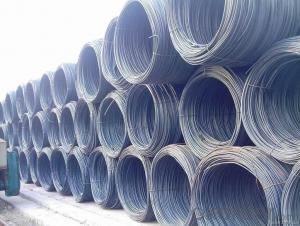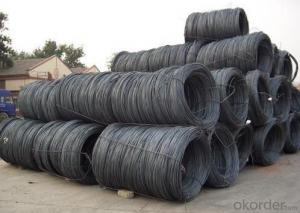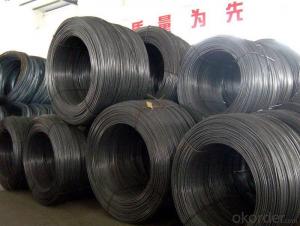Wire Rods Steel for Construction/ Concrete Usage
- Loading Port:
- Tianjin
- Payment Terms:
- TT or LC
- Min Order Qty:
- 28 m.t.
- Supply Capability:
- 40000 m.t./month
OKorder Service Pledge
OKorder Financial Service
You Might Also Like
Product Description:
OKorder is offering Wire Rods Steel for Construction/ Concrete Usage at great prices with worldwide shipping. Our supplier is a world-class manufacturer of steel, with our products utilized the world over. OKorder annually supplies products to European, North American and Asian markets. We provide quotations within 24 hours of receiving an inquiry and guarantee competitive prices.
Product Applications:
Wire Rods Steel for Construction/ Concrete Usage are ideal for structural applications and are widely used in the construction of buildings and bridges, and the manufacturing, petrochemical, and transportation industries.
Product Advantages:
OKorder's Wire Rods Steel for Construction/ Concrete Usage are durable, strong, and resist corrosion.
Main Product Features:
· Premium quality
· Prompt delivery & seaworthy packing (30 days after receiving deposit)
· Corrosion resistance
· Can be recycled and reused
· Mill test certification
· Professional Service
· Competitive pricing
Product Specifications:
wire rod:
Grade:SAE1006B/SAE1008B/SAE1018B
Size:5.5/6.5/7/8/9/10/11/12mm
wire rods are suitable for a wide range of applications such as : -
fasteners, bolts, rivets, screws,
general purpose wires,
electrode wires, industrial wires, agriculture wires,
bush wires, chain rivet wires,
detonator wire,
Umbrella ribs, upholstery wires, cycle spokes, needle wires, heald wires, staple pin Wire, safety pin wires
ACSR wires, earth wires,
tyre and hose reinforcement wires,
prestressed concrete wire, springs and rope wires,
card clothing wires,
vineyard wires,
ball bearing quality
Automobile parts like screw, fasteners, bush, spline, socket, connecting rod, shaft, gear, rivets, engine shaft, connecting rod, spindles, gears, etc.
FAQ:
Q1: Why buy Materials & Equipment from OKorder.com?
A1: All products offered byOKorder.com are carefully selected from China's most reliable manufacturing enterprises. Through its ISO certifications, OKorder.com adheres to the highest standards and a commitment to supply chain safety and customer satisfaction.
Q2: How do we guarantee the quality of our products?
A2: We have established an advanced quality management system which conducts strict quality tests at every step, from raw materials to the final product. At the same time, we provide extensive follow-up service assurances as required.
Q3: How soon can we receive the product after purchase?
A3: Within three days of placing an order, we will begin production. The specific shipping date is dependent upon international and government factors, but is typically 7 to 10 workdays.
Q4: What makes stainless steel stainless?
A4: Stainless steel must contain at least 10.5 % chromium. It is this element that reacts with the oxygen in the air to form a complex chrome-oxide surface layer that is invisible but strong enough to prevent further oxygen from "staining" (rusting) the surface. Higher levels of chromium and the addition of other alloying elements such as nickel and molybdenum enhance this surface layer and improve the corrosion resistance of the stainless material.
Q5: Can stainless steel rust?
A5: Stainless does not "rust" as you think of regular steel rusting with a red oxide on the surface that flakes off. If you see red rust it is probably due to some iron particles that have contaminated the surface of the stainless steel and it is these iron particles that are rusting. Look at the source of the rusting and see if you can remove it from the surface.
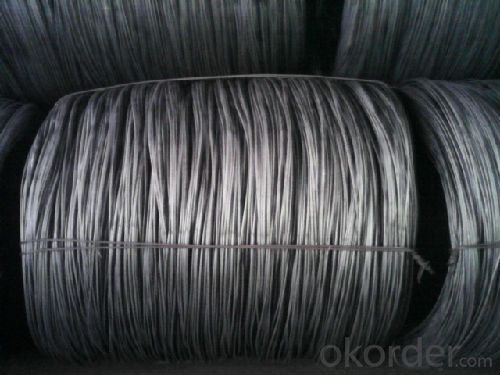
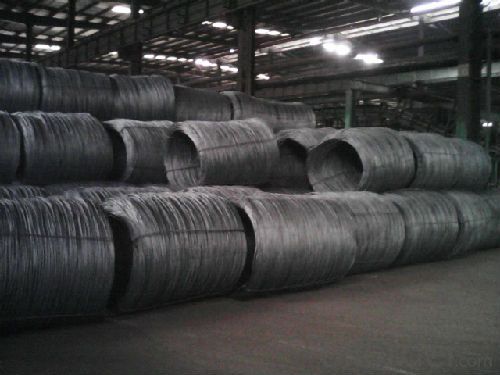
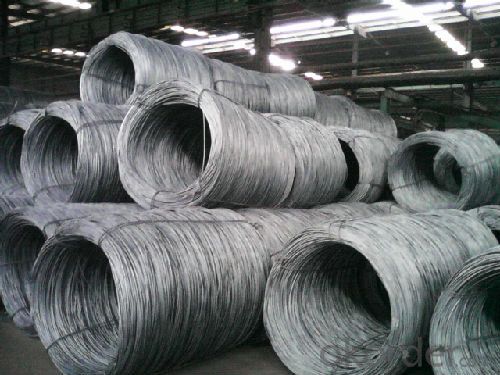
- Q:How is steel wire rod used in the manufacturing of wire forms for power transmission systems?
- Steel wire rod is used in the manufacturing of wire forms for power transmission systems as it serves as the raw material for creating strong and durable wires. These wires are then used to produce various components like cables, conductors, and connectors that are essential for transmitting electric power efficiently and reliably.
- Q:How is steel wire rod classified based on its diameter?
- Steel wire rod is classified based on its diameter into various categories. The classification is typically done using a wire gauge system or by specifying the diameter directly in millimeters. The wire gauge system assigns a numerical value to different wire diameters, with higher numbers indicating thinner wires. For example, in the United States, the American Wire Gauge (AWG) system is commonly used. In this system, the thickest wire is assigned the gauge number 0000 (four zeros), while the thinnest wire has a gauge number of 40. Each gauge number corresponds to a specific diameter range. Alternatively, steel wire rod can also be classified based on its diameter in millimeters. This approach directly specifies the exact diameter of the wire rod, allowing for more precise classification. For example, a wire rod with a diameter of 5.5 mm would be classified as such. Both methods of classification provide a standardized way to categorize steel wire rod based on its diameter. This information is important for various industries that utilize steel wire rod, such as construction, automotive, and manufacturing, as it allows them to select the appropriate wire rod for their specific applications.
- Q:What are the different types of steel wire rod coatings used for improved heat resistance?
- There are several types of steel wire rod coatings used for improved heat resistance. Some common coatings include zinc-based coatings, aluminum-based coatings, and ceramic coatings. These coatings provide a protective barrier that enhances the wire rod's ability to withstand high temperatures and prevent oxidation or corrosion. Additionally, these coatings can also improve the wire rod's overall durability and longevity in high-temperature environments.
- Q:What are the common production processes for phosphorus-coated steel wire rod?
- The common production processes for phosphorus-coated steel wire rod typically include wire drawing, annealing, coating application, and curing.
- Q:How is steel wire rod used in the production of wire for medical devices?
- Steel wire rod plays a critical role in producing wire for medical devices. It serves as the primary material that undergoes processing and transformation to become the final wire product used in various medical applications. The manufacturing process involves several steps, starting with the careful selection of high-quality steel wire rod. To ensure that the steel wire rod meets the strict requirements for medical devices, it is examined for its chemical composition, mechanical properties, and surface condition. These properties directly affect the wire's performance, strength, and resistance to corrosion and other environmental factors. Once the suitable steel wire rod is chosen, it goes through a series of manufacturing processes to convert it into wire for medical devices. These processes include cleaning, drawing, annealing, and coating. Cleaning removes any impurities or contaminants from the wire rod's surface, ensuring a clean and defect-free wire. Drawing is a crucial process where the steel wire rod is pulled through dies to gradually reduce its diameter, resulting in the desired thickness of the wire. This drawing process also enhances the wire's mechanical properties, such as tensile strength and flexibility, making it suitable for medical applications. After the drawing process, annealing is often performed to relieve any internal stresses accumulated during drawing and improve the wire's ductility. This step involves heating the wire to a specific temperature and then slowly cooling it. Annealing enhances the wire's flexibility and makes it more pliable for further processing. Coating is the final step in wire production for medical devices. Depending on the specific application, the wire may be coated with polymers or metals to provide additional protection against corrosion, improve biocompatibility, or enhance lubricity. The wire produced from steel wire rod is then used in the manufacturing of various medical devices, including catheters, guide wires, sutures, orthopedic implants, and stents. The high-quality steel wire rod ensures that the wire used in these devices meets the necessary standards of strength, flexibility, and durability required for medical use. In conclusion, steel wire rod is a crucial component in the production of wire for medical devices. Its careful selection and subsequent processing through cleaning, drawing, annealing, and coating result in a wire that meets the stringent requirements of medical applications. This wire is then utilized in the manufacturing of various medical devices, contributing to the advancement and improvement of healthcare worldwide.
- Q:How is steel wire rod used in the manufacturing of wire for cable harnesses?
- Steel wire rod is used in the manufacturing of wire for cable harnesses as it provides the necessary strength and durability required for the cables. The wire rod is first drawn through a series of dies to reduce its diameter and increase its length. This process, known as wire drawing, results in a fine and smooth wire that can be easily bent and shaped without breaking. The wire is then further processed and insulated to meet the specific requirements of cable harnesses, such as conducting electricity, transmitting signals, or supporting heavy loads. Overall, steel wire rod is a crucial component in the production of wire for cable harnesses, ensuring their reliability and performance.
- Q:What are the different surface marking methods for steel wire rod?
- Steel wire rods can be marked using various surface marking methods, each serving the purpose of identifying and providing information about the wire rod. One commonly used method involves hot stamping, which impresses an identification mark onto the surface of the wire rod using a heated stamp. This method is reliable and long-lasting since the mark becomes permanently engraved on the steel's surface. Another technique, inkjet printing, involves using an inkjet printer to directly print the necessary information onto the steel wire rod. This method is speedy and allows for flexibility in marking different types of information. Laser marking is also a popular choice, where a laser beam is utilized to remove or alter the surface material of the wire rod, leaving a permanent mark. This method offers precise and detailed markings. Moreover, embossing or engraving can be utilized to create raised or indented markings on the wire rod's surface. These methods are often employed for branding or decorative purposes, but can also convey important information about the wire rod. Ultimately, the selection of a surface marking method for steel wire rods depends on the manufacturer's specific requirements and preferences. Each method has its own advantages and limitations, necessitating careful consideration to ensure accurate and durable markings on the wire rods.
- Q:How is the dimensional accuracy of steel wire rod measured?
- The dimensional accuracy of steel wire rod is commonly assessed using various techniques and tools to ensure that the rod meets the necessary specifications. Several commonly employed methods for measuring the dimensional accuracy of steel wire rod are as follows: 1. Calipers are utilized to gauge the diameter of the steel wire rod. These calipers can be either manual or digital and provide precise measurements by securely gripping the rod and determining its diameter. 2. Micrometers are highly accurate measurement tools employed to assess the diameter of the steel wire rod. They yield extremely precise readings by utilizing a calibrated screw mechanism to measure the dimensions. 3. Optical measurement systems employ advanced technology, such as lasers or cameras, to measure the dimensions of the steel wire rod. These systems rapidly and accurately capture multiple data points and analyze them to ascertain the dimensional accuracy. 4. Ultrasonic measurement techniques entail emitting ultrasonic waves into the steel wire rod and analyzing the reflected waves to determine its dimensions. This method is particularly useful for measuring the thickness and cross-sectional dimensions of the rod. 5. Automated measurement systems make use of specialized equipment and software to measure the dimensional accuracy of steel wire rods. These systems employ robotics, sensors, and image processing algorithms to provide accurate and consistent measurements. It is important to note that the specific measurement technique employed may vary depending on the required dimensions, tolerances, and the capabilities of the manufacturer or testing facility.
- Q:How is steel wire rod stored to prevent corrosion?
- Steel wire rods are typically stored in a way that minimizes the risk of corrosion. One common method is to store the rods in a well-ventilated area with controlled humidity levels. This helps to prevent the build-up of moisture, which can accelerate the corrosion process. Another preventive measure is to store the steel wire rods in a dry environment and off the ground. This can be achieved by placing the rods on pallets or racks, ensuring that they are not in direct contact with the floor. By keeping the rods elevated, any potential moisture or water accumulation on the ground is avoided. Furthermore, steel wire rods can be stored indoors in a climate-controlled warehouse. Maintaining a stable temperature and humidity level can significantly reduce the chances of corrosion. These controlled environments help to minimize moisture exposure and prevent the formation of rust on the wire rods. In addition to these storage practices, coating the steel wire rods with a protective layer is also a common preventive measure. This can be done by applying a corrosion-resistant coating such as zinc or epoxy. The coating acts as a barrier between the rods and the surrounding environment, preventing moisture from reaching the surface of the wire rods and causing corrosion. Overall, proper storage of steel wire rods involves minimizing moisture exposure, maintaining controlled humidity levels, keeping the rods off the ground, and using protective coatings. By implementing these measures, the risk of corrosion is significantly reduced, ensuring that the steel wire rods remain in optimal condition until they are ready for use.
- Q:How is steel wire rod used in the manufacturing of wire netting?
- Steel wire rod is used in the manufacturing of wire netting as the primary material. It is drawn through a series of dies to reduce its diameter and increase its length, resulting in a thin and elongated wire. This wire is then woven or welded together to form the mesh structure of the wire netting. The high tensile strength and durability of steel wire rod make it an ideal choice for constructing wire netting, which is commonly used for fencing, screening, and reinforcement purposes in various industries.
1. Manufacturer Overview |
|
|---|---|
| Location | |
| Year Established | |
| Annual Output Value | |
| Main Markets | |
| Company Certifications | |
2. Manufacturer Certificates |
|
|---|---|
| a) Certification Name | |
| Range | |
| Reference | |
| Validity Period | |
3. Manufacturer Capability |
|
|---|---|
| a)Trade Capacity | |
| Nearest Port | |
| Export Percentage | |
| No.of Employees in Trade Department | |
| Language Spoken: | |
| b)Factory Information | |
| Factory Size: | |
| No. of Production Lines | |
| Contract Manufacturing | |
| Product Price Range | |
Send your message to us
Wire Rods Steel for Construction/ Concrete Usage
- Loading Port:
- Tianjin
- Payment Terms:
- TT or LC
- Min Order Qty:
- 28 m.t.
- Supply Capability:
- 40000 m.t./month
OKorder Service Pledge
OKorder Financial Service
Similar products
New products
Hot products
Related keywords
